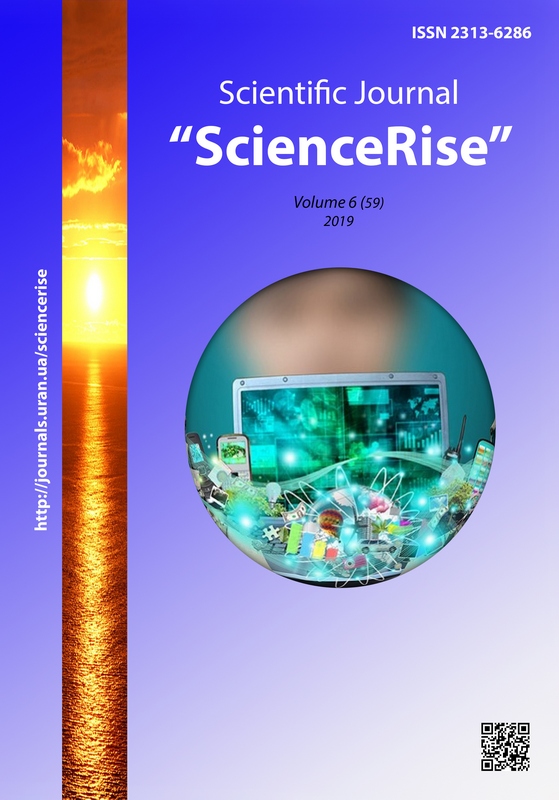Analysis of the rotative potential of two-frequency oscillation of water molecule
DOI:
https://doi.org/10.15587/2313-8416.2019.170742Keywords:
water molecule, two-frequency pendulum, inhomogeneous field of forces, toroidal potentialAbstract
The rotational oscillations of a water molecule are considered using the model of a two-frequency physical pendulum and it is shown that the type of its potential is correctly described as toroidal. It is shown that the ellipticity of the toroidal potential in a non-uniform force field decreases with an increase in the exponent n than for an ellipsoidal one, however, both potentials become close. A decrease in the ellipticity of the toroidal potential in this field can lead to the expansion of the region of existence of elliptical-like oscillations of the two-frequency pendulum towards its lower speeds
References
Antonchenko, V. Ia., Davydov, A. S., Ilin, V. V. (1991). Osnovy fiziki vody. Kyiv: Naukova Dumka, 672.
Eizenberg, D., Kautsman, V. (1975). Struktura i svoistva vody. Leningrad: Gidrometeoizdat, 280.
Bersuker, I. B. (1987). Effekt Iana – Tellera i vibronnye vzaimodeistviia v sovremennoi khimii. Moscow: Nauka, 344.
Malafaev, N. T. (2011). About interactions and dynamics of molecules in pure water. Eastern-European Journal of Enterprise Technologies, 52 (4 (8)), 48–58. Available at: http://journals.uran.ua/eejet/article/view/1465/1363
Malafayev, N. T., Pogozhikh, N. I. (2015). Features rotational of vibrations of water molecules. Eastern-European Journal of Enterprise Technologies, 2 (5 (74)), 27–35. doi: http://doi.org/10.15587/1729-4061.2015.40569
Malenkov, G. G. (2006). Structure and dynamics of liquid water. Journal of Structural Chemistry, 47 (1), 5–35. doi: http://doi.org/10.1007/s10947-006-0375-8
Zel’dovich, B. Y., Soileau, M. J. (2004). Bi-frequency pendulum on a rotary platform: modeling various optical phenomena. Uspekhi Fizicheskih Nauk, 174 (12), 1337–1354. doi: http://doi.org/10.3367/ufnr.0174.200412e.1337
Kondratev, B. P., Dubrovskii, A. S., Trubitsyna, N. G., Mukhametshina, E. Sh. (2008). Prostranstvennii potentsial odnorodnogo krugovogo tora cherez ekvigravitiruiushchie element. Zhurnal tekhnicheskoi fiziki, 78 (7), 132–135.
Higgs, J. M., Petersen, B. V., Lammert, S. A., Warnick, K. F., Austin, D. E. (2016). Radiofrequency trapping of ions in a pure toroidal potential distribution. International Journal of Mass Spectrometry, 395, 20–26. doi: http://doi.org/10.1016/j.ijms.2015.11.009
Wu, S.-T., Chen, Y.-R., Wang, S.-S. (2011). Two-degree-of-freedom rotational-pendulum vibration absorbers. Journal of Sound and Vibration, 330 (6), 1052–1064. doi: http://doi.org/10.1016/j.jsv.2010.09.028
Malafaev, N. Т. (2016). Rotational oscillations of water molecules as oscillations of a spherical pendulum in an inhomogeneous field of forces. ScienceRise, 2 (2 (19)), 62–69. doi: http://doi.org/10.15587/2313-8416.2016.60587
Water Models. Available at: http://www.lsbu.ac.uk/water/models.html
Makhlaichuk, P. V., Malomuzh, M. P., Zhyganiuk, I. V. (2013). Dimerization of water molecules modeling of the attractive part of the interparticle potential in the multipole approximation. Ukrainian Journal of Physics, 58 (3), 278–288. doi: http://doi.org/10.15407/ujpe58.03.0278
Downloads
Published
Issue
Section
License
Copyright (c) 2019 Nikolay Malafayev

This work is licensed under a Creative Commons Attribution 4.0 International License.
Our journal abides by the Creative Commons CC BY copyright rights and permissions for open access journals.
Authors, who are published in this journal, agree to the following conditions:
1. The authors reserve the right to authorship of the work and pass the first publication right of this work to the journal under the terms of a Creative Commons CC BY, which allows others to freely distribute the published research with the obligatory reference to the authors of the original work and the first publication of the work in this journal.
2. The authors have the right to conclude separate supplement agreements that relate to non-exclusive work distribution in the form in which it has been published by the journal (for example, to upload the work to the online storage of the journal or publish it as part of a monograph), provided that the reference to the first publication of the work in this journal is included.

